Exam Details
Exam Code
:3V0-41.19Exam Name
:Advanced Design NSX-T Data Center 2.4Certification
:VMware CertificationsVendor
:VMwareTotal Questions
:50 Q&AsLast Updated
:Dec 22, 2024
VMware VMware Certifications 3V0-41.19 Questions & Answers
-
Question 11:
An architect is helping an organization redesign a previously installed NSX-T Data Center solution. This information was gathered during the Assessment Phase:
1.
The company's headquarters Is located In Eastern Europe and there are several regional offices.
2.
The company owns several smaller companies around the globe.
3.
All locations must access the RESTful API of NSX-T through the internal network for automating the
creation of segments.
4.
The company's HQ does not have any internal Public Key Infrastructure.
5.
NSX-T has already been installed at the company's headquarters.
The architect has determined self-signed certificates should be replaced with certificates signed by a
Public Key Infrastructure.
Which should the architect recommend in their design?
A. Replace the certificate on all three NSX Managers with a certificate that is signed by a third-party Public Key Infrastructure.
B. Replace the NSX-T root certificate with an internal Certificate Authority.
C. Replace the NSX Managers certificate with a certificate that Is signed by Company Public Key Infrastructure.
D. Replace vCenter root certificate with a certificate signed by a third-party Certificate Authority.
-
Question 12:
Refer to the exhibit.
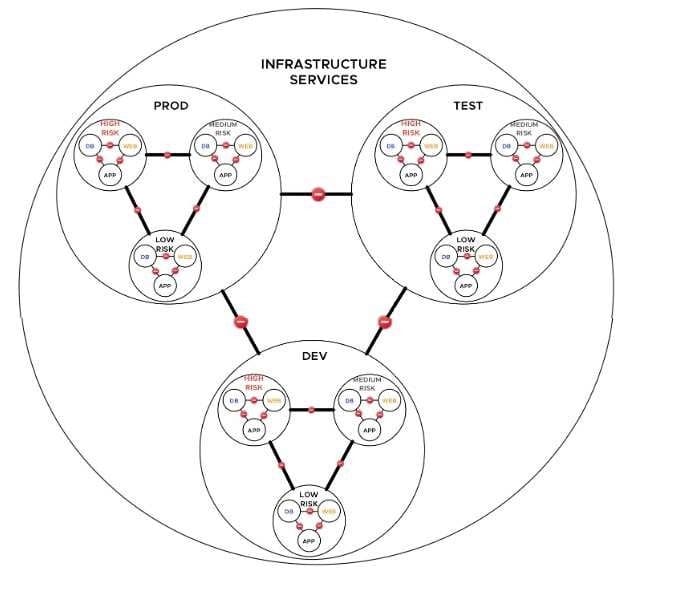
A financial company is adopting micro-services with the intent of simplifying network security. An NSX-T
architect is proposing a NSX-T Data Center micro-segmentation logical design. The architect has created
a diagram to share with the customer.
How many security levels will be implemented according to this Logical Design?
A. 6 levels
B. 9 Levels
C. 2 levels
D. 4 Levels
-
Question 13:
An architect is helping an organization with the Logical Design of an NSX-T Data Center solution. This information was gathered during the Assessment Phase:
1.
Customer Is In the business of providing website hosting and network services for a variety of organizations.
2.
Customer is considering adopting NSX-T Data Center as their network virtualization solution.
3.
4000 virtual servers are being managed today.
4.
Virtual server growth is expected to be 10% bi-yearly for critical public facing web servers.
5.
To cope with increased demand, the customer is acquiring all new infrastructure components.
6.
Customer Is concerned with the cost effectiveness of any proposed solution.
Which two should the architect include in their design? (Choose two.)
A. 2U Rack with 14 servers in each rack having 24 Cores and 4 TB of RAM and 40 GB aggregate bandwidth
B. verified and supported hardware with at least 4 CPU cores
C. 48 port switch with 1000 Mbps transfer rate
D. verified and supported hardware a with minimum of 16 GB of RAM
E. medium size Edge Virtual Machine
-
Question 14:
An architect is helping an organization with the Logical Design of a Layer 2 bridging solution. This information was gathered during the Assessment Phase:
1.
Workloads are running on ESXI hosts.
2.
Workloads are running on KVM hosts.
3.
Workloads on both type of hypervisors should use bridging services.
4.
VLAN 50 is used for Tier-0 uplink connectivity.
Which should the architect include in their design?
A. Create an NSX Edge Bridge Cluster and configure the bridging profile with VLAN 60.
B. Create an ESXi Bridge Cluster and configure the bridging profile with VLAN 60.
C. Create an NSX Edge Bridge Cluster and configure the bridging profile with VLAN 50.
D. Create an ESXi Bridge Cluster and configure the bridging profile with VLAN 50.
-
Question 15:
An architect is helping an organization with the Logical Design of an NSX-T Data Center solution. This information was gathered during the Assessment Phase:
1.
NSX-T will span across two sites for disaster recovery.
2.
Public Load Balancer VIP should be accessible from a secondary site.
3.
Distributed Firewall Policies should be available at a secondary site.
4.
Routing capabilities should be maintained after failure.
5.
NAT capabilities are required.
Which two should the architect include in their design? (Choose two.)
A. Use IP sets or groups to configure DFW rules.
B. Use MTU to 1550 between sites.
C. Use of the same ISPs across sites.
D. Use two separate ISPs across sites.
E. Set MTU to 1500 between sites.
-
Question 16:
An architect is helping an organization with the Physical Design of an NSX-T Data Center solution. This information was gathered during a workshop:
1.
Any proposed solution must provide low latency.
2.
Any proposed solution must provide high throughput.
3.
Customer is running stock trading applications.
Which two should the architect recommend to meet high-performance workload requirements? (Choose two.)
A. Enable enhanced data path mode on the N-VDS.
B. Leverage ESX as the compute host.
C. Leverage KVM as the compute host.
D. Enable latency sensitivity mode on the N-VDS.
E. Use LACP for all uplink profiles.
-
Question 17:
Refer to exhibit: An NSX architect is creating a Greenfield NSX-T Data Center solution using IPv6 addressing. This solution will form the starting point for a migration away from IPv4 addressing in the data center.
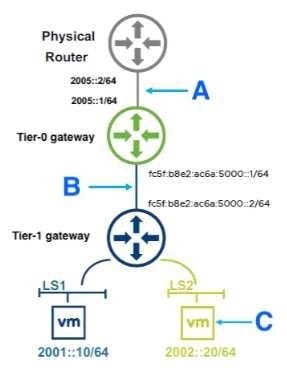
What are three correct labels for locations A, B, and C in the exhibit? (Choose three.)
A. Static IPv4 Addresses
B. Auto assigned from fc5f:b8e2:ac6a::/48 Unique Local
C. Static IPv6 addresses
D. Auto Assigned from fe:::::/48 Unique Local
E. DHCP relay for IPv4
F. Static IPv6 addresses and DHCP Relay
-
Question 18:
What would an architect recommend to a customer that wants to extend management to an additional data center through Layer 2, but does not want to add additional NSX-T licensing?
A. Deploy a standalone Edge as the L2 VPN client.
B. Deploy a standalone NSX Controller.
C. Deploy a standalone NSX Manager.
D. Deploy a standalone Edge as the IPSec VPN.
-
Question 19:
Refer to the exhibits.
An architect is helping an organization with the Logical Design of an NSX-T Data Center solution. This
information was gathered during the Assessment Phase:
1.
Existing network hardware must be used.
2.
Existing ESXi hosts with 2 pNICS must be used.
3.
One vCenter must be used for virtual environment management.
4.
Customer is concerned NSX-T will use too many resources.
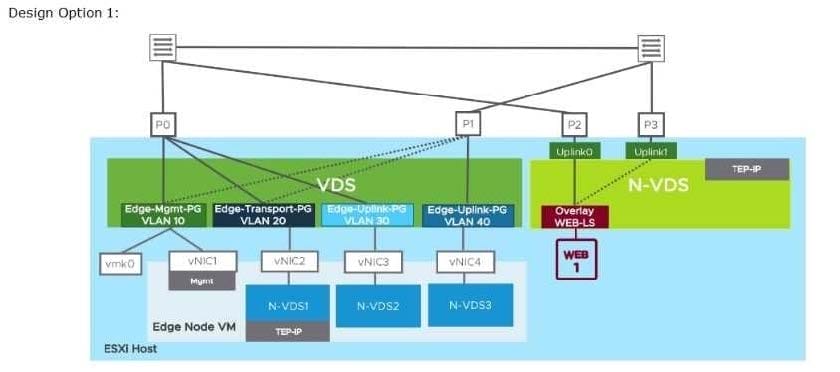
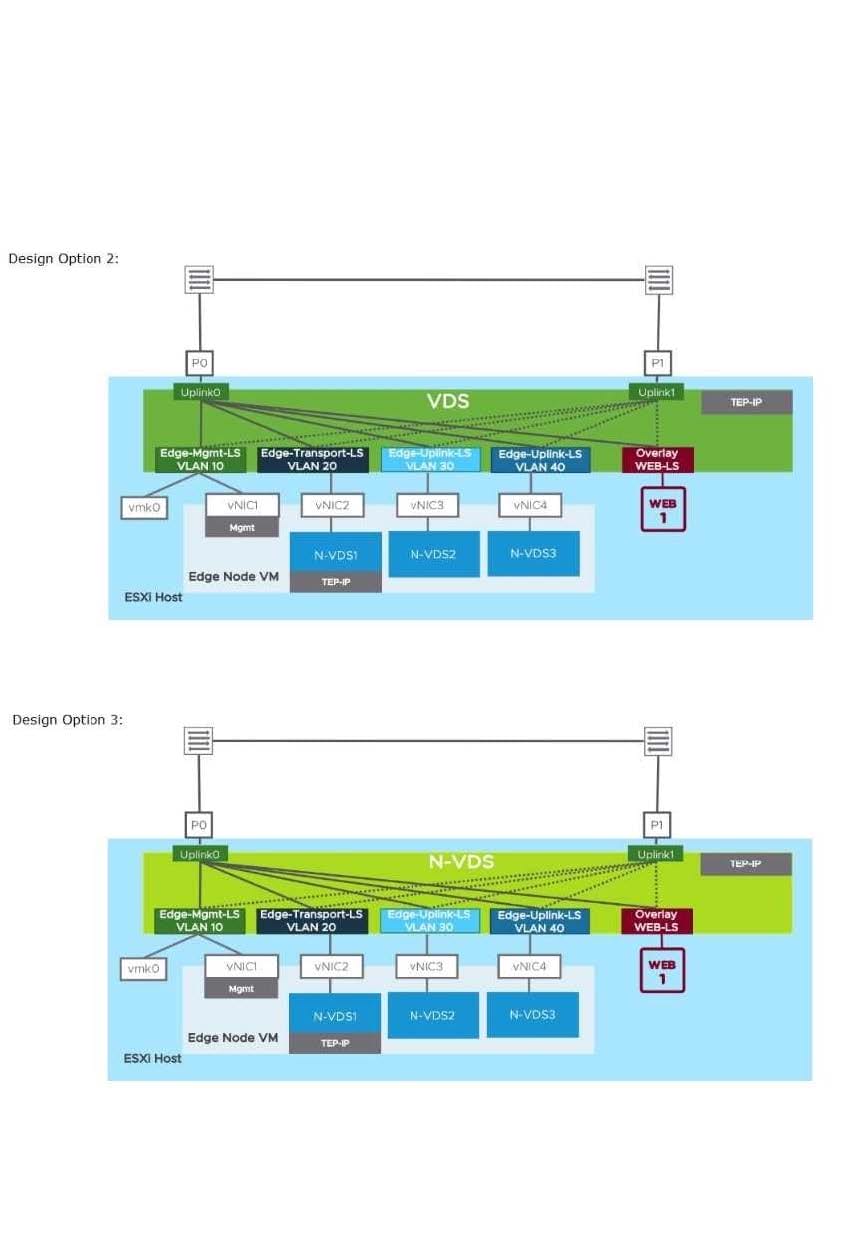
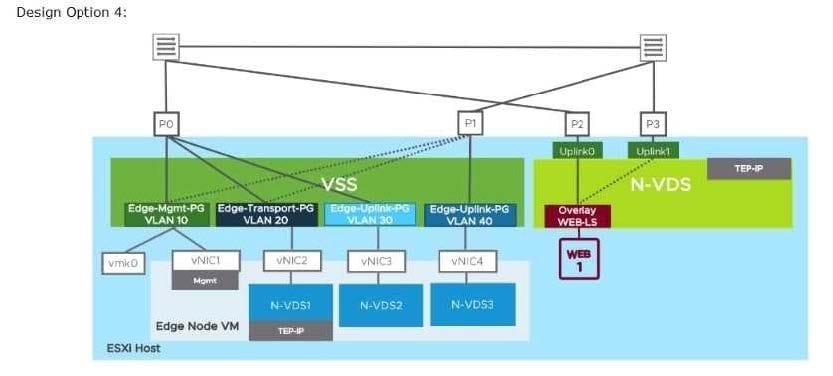
Which design option should the architect propose to the customer?
A. Design Option 3
B. Design Option 4
C. Design Option 1
D. Design Option 2
-
Question 20:
An architect is helping an organization with the Conceptual Design of an NSX-T Data Center solution. This information was gathered by the architect during the Discover Task of the Engagement Lifecycle:
1.
There are applications which use IPv6 addressing.
2.
Network administrators are not familiar with NSX-T Data Center solutions.
3.
Hosts can only be configured with two physical NICs.
4.
There is an existing management cluster to deploy the NSX-T components.
5.
Dynamic routing should be configured between the physical and virtual network.
6.
There is a storage array available to deploy NSX-T components.
Which constraint was documented by the architect?
A. There are applications which use IPv6 addressing.
B. There are enough CPU and memory resources in the existing management cluster.
C. Dynamic routing should be configured between the physical and virtual network.
D. Hosts can only be configured with two physical NICs.
Related Exams:
1V0-21.20
Associate VMware Data Center Virtualization1V0-31.21
Associate VMware Cloud Management and Automation1V0-41.20
Associate VMware Network Virtualization1V0-61.21
Associate VMware Digital Workspace1V0-71.21
Associate VMware Application Modernization1V0-81.20
Associate VMware Security2V0-21.20
Professional VMware vSphere 7.x2V0-21.23
VMware vSphere 8.x Professional2V0-31.21
Professional VMware vRealize Automation 8.32V0-31.23
VMware Aria Automation 8.10 Professional
Tips on How to Prepare for the Exams
Nowadays, the certification exams become more and more important and required by more and more enterprises when applying for a job. But how to prepare for the exam effectively? How to prepare for the exam in a short time with less efforts? How to get a ideal result and how to find the most reliable resources? Here on Vcedump.com, you will find all the answers. Vcedump.com provide not only VMware exam questions, answers and explanations but also complete assistance on your exam preparation and certification application. If you are confused on your 3V0-41.19 exam preparations and VMware certification application, do not hesitate to visit our Vcedump.com to find your solutions here.